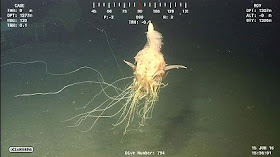The Okeanos Explorer's primary objective here is to map and document the communites which form the habitat and primary fauna of this region. And so, a majority of their time goes towards studying the many, MANY deep-sea sponges and corals which make up these habitats.
The main page for the NOAA Hawaiian Expedition can be found here.
Their LIVE feed can be found here.
I've been tweeting the LIVE stream of the Okeanos' various discoveries and last week I documented the many, MANY different types of glass sponges seen by the Okeanos Explorer.
This week I thought I would just digest some of the various discoveries made which I thought warranted a place in today's post! Although most of the screengrabs here are mine, I am ETERNALLY grateful to the Facebook Underwater screengrab group!
1. Is this the world's LARGEST KNOWN SPONGE??? (Glass sponge or otherwise??)
Here was a pic of the ROV Deep Discoverer NEXT to the sponge. it was approximately 3.5 m long X 2.5 m tall, that's about 11 feet x 8 feet LONG!
Sponges and corals are known as "ecosystem engineers" because they play host to numerous other species and essentially become huge hubs of biodiversity. Many, MANY other animals live on these sponge colonies: brittle stars, starfish, squat lobsters, etc. the list goes on...
SOMETIMES, the community is a little more permanent than others. Here's a shrimp which lives inside this "glass cage" sponge. This species mates and lives inside the sponge for the rest of its life...
This story, of the "Venus flower basket" which is a pretty obvious deep-sea invertebrate "love story" is seen in the genus Euplectella. One can find more accounts of this story all over, such as here.
2. Starfish FEED on glass sponges!
You wouldn't think there would be much on a glass sponge to eat, being composed primarily of... glass (see last week) but there IS that syncytium, the weird cytoplasm like stuff that covers the glass skeleton and a starfish has gotta eat..
Some goniasterid that is not clearly identifiable..
A "wolf pack" of Henricia sp. approaching on and feeding on this fallen glass sponge..
3. There are multiple species of deep-sea starfish which feed on corals too!
One of my primary research interests and one of my favorite things to watch are deep-sea goniasterid starfish feeding on corals. I worked on these for my PhD and have described several new species of these animals (here) and here. and even here
In Hawaii, there are several species of coral-devouring sea stars. Many of them display a fairly prominent border of spines around their body...
Calliaster pedicellaris
Evoplosoma, probably E. forcipifera
and a new species I described last year, Hippasteria muscipula!
4. Special Weird Deep-Sea Treats! The Bottom-living or "dandelion" siphonophore!!
A siphonophore is a gelatinous animal that is a sort of colonial jellyfish closely related to the Portuguese man-o-war. Siphonophores are best known as swimmers in the pelagic or open ocean. In the deep-sea, there are some species which live near the sea bottom and float above the surface, dragging their tentacles along the surface..
If the weird beast above seems kinda familiar, you may have seen another species of this "dandelion" siphonophore in other news....such as this one from Africa which has been making the news rounds as a weird "spaghetti monster"
The mystery of the million barnacle plates! The bottom was littered with millions of barnacle plates, but WHERE ARE THE BARNACLES??
We did see a few, but were they even the same species??
5. and my personal favorite..a sea urchin called Aspidodiadema hawaiiensis! A strange sea urchin that looks like the spider robot from Johnny Quest! I've mentioned these before in my post about HURL's deep-sea Hawaiian urchins
These seem to move around via a combination of their tube feet and these long bowed spines which seem to extend to the surface.
Also of interest are the beak-like structures near the base. These are called pedicellariae and given how large and prominent they are, I would speculate that they are extended for defense. Perhaps to protect the tube feet??
I also love these animals because they resemble the "robot spy" from Johnny Quest!
And yeah, post this week was a bit late. Laptop in the shop! More next week!



















No comments:
Post a Comment